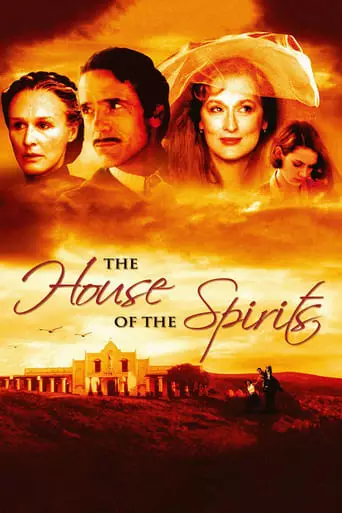
The House of the Spirits (1993) Watch Online Free
A rancher, his clairvoyant wife and their family face turbulent years in South America.
he House of the Spirits (1993) is a sweeping drama based on Isabel Allende’s iconic novel, set against the backdrop of political upheaval in Chile. Directed by Bille August, the film spans several generations, focusing on the lives of the Trueba family, particularly the experiences of the strong women who drive its narrative. The movie features an ensemble cast, including Jeremy Irons, Meryl Streep, Glenn Close, Winona Ryder, and Antonio Banderas, and blends themes of love, loss, power, and social change with elements of the supernatural.
The film begins in the 1920s, with the love story of Esteban Trueba (Jeremy Irons) and Rosa Del Valle (Teri Polo). Esteban, a young man of humble beginnings, falls in love with Rosa, but she is tragically killed before they can marry. Esteban, devastated by her death, builds a prosperous life through hard work and exploitation of the poor, eventually becoming a wealthy and powerful landowner.
Esteban marries Clara (Meryl Streep), Rosa’s sister, who has telekinetic powers. Their marriage is marked by both love and turbulence, as Esteban’s authoritarian tendencies clash with Clara’s spiritual and compassionate nature. The story follows their daughter, Blanca (Winona Ryder), who becomes involved with Pedro (Antonio Banderas), a revolutionary. As political tensions rise, the family experiences both personal and societal upheavals, culminating in a military coup that threatens their very existence.
The central themes of The House of the Spirits revolve around the complexities of power, love, and social class, set within the volatile political landscape of 20th-century Chile. The film explores the tensions between the oppressive patriarchal system represented by Esteban and the more progressive, empathetic forces embodied by Clara and the revolutionary movements. The supernatural elements, such as Clara’s psychic abilities, are symbolic of the deeper emotional and spiritual connections that transcend the material world, highlighting the intersection of personal and political struggles.
The film also critiques the class divide, with Esteban’s rise to power reflecting the exploitation of the working class and the brutal realities of wealth and privilege. The generational shift seen through the characters of Clara, Blanca, and Pedro speaks to the evolving nature of resistance, as well as the persistence of inequality and injustice.
The House of the Spirits had a significant cultural impact, particularly in its portrayal of Latin American history and the power dynamics at play within the family structure. The film’s blend of historical fiction and magical realism offers a rich, complex narrative that engages with both personal and political themes. Its exploration of the supernatural and emotional depth adds layers to the historical context, making it an evocative commentary on the resilience of individuals and families amidst the forces of history.
After watching The House of the Spirits, viewers will likely feel a mix of awe and sadness. The film’s emotional depth, combined with its exploration of political and personal struggles, leaves a lasting impression. The poignant moments of love and loss, alongside the exploration of the harsh realities of life under a repressive regime, may evoke feelings of empathy and reflection. The supernatural elements also provide a sense of wonder, but the overall tone of the film is one of melancholy and contemplation, making it a thought-provoking experience long after the credits roll
